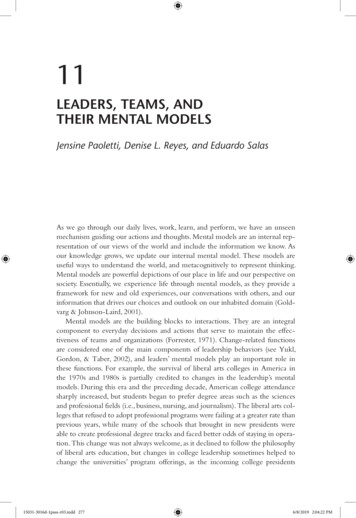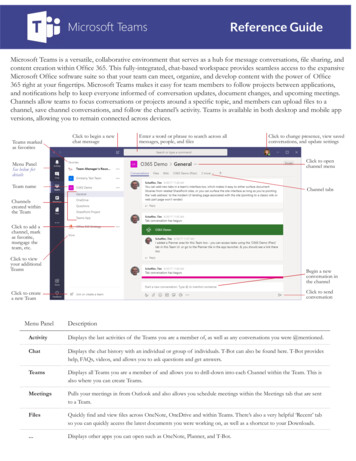
Transcription
11LEADERS, TEAMS, ANDTHEIR MENTAL MODELSJensine Paoletti, Denise L. Reyes, and Eduardo SalasAs we go through our daily lives, work, learn, and perform, we have an unseenmechanism guiding our actions and thoughts. Mental models are an internal representation of our views of the world and include the information we know. Asour knowledge grows, we update our internal mental model. These models areuseful ways to understand the world, and metacognitively to represent thinking.Mental models are powerful depictions of our place in life and our perspective onsociety. Essentially, we experience life through mental models, as they provide aframework for new and old experiences, our conversations with others, and ourinformation that drives our choices and outlook on our inhabited domain (Goldvarg & Johnson-Laird, 2001).Mental models are the building blocks to interactions. They are an integralcomponent to everyday decisions and actions that serve to maintain the effectiveness of teams and organizations (Forrester, 1971). Change-related functionsare considered one of the main components of leadership behaviors (see Yukl,Gordon, & Taber, 2002), and leaders’ mental models play an important role inthese functions. For example, the survival of liberal arts colleges in America inthe 1970s and 1980s is partially credited to changes in the leadership’s mentalmodels. During this era and the preceding decade, American college attendancesharply increased, but students began to prefer degree areas such as the sciencesand professional fields (i.e., business, nursing, and journalism). The liberal arts colleges that refused to adopt professional programs were failing at a greater rate thanprevious years, while many of the schools that brought in new presidents wereable to create professional degree tracks and faced better odds of staying in operation. This change was not always welcome, as it declined to follow the philosophyof liberal arts education, but changes in college leadership sometimes helped tochange the universities’ program offerings, as the incoming college presidents15031-3016d-1pass-r03.indd 2776/8/2019 2:04:22 PM
278 Jensine Paoletti et al.brought their previous organization’s mental model of professional degrees withinliberal arts education. Some of these new leaders came from state universities,some migrated from liberal arts colleges that had adopted professional programs,while others moved from non-selective universities. The college presidents fromliberal arts colleges with professional programs and from the non-selective universities tended to adopt professional programs at their new liberal arts colleges,thus making their new colleges more competitive for the changing consumerdemands (Kraatz & Moore, 2002). While the strategies of liberal arts colleges arenot applicable to every organization, one lesson remains: leaders’ mental modelsare important.A divergent example is the Egyptian revolution, which occurred in 2011.Mohga Badran, management professor at the American University in Cairo credits shared mental models with the success of the Egyptian Revolution; “this wasa leaderless revolution. The vision was the leader. Leadership was not a person.It was a feeling, a mental model, and a vision” (Youssef, 2011, p. 226). The article goes on to describe how the people shared a mental model desiring changein their country after seeing a similar regime change in Tunisia. Throughoutthe course of the revolution, there was a shifting vision and a shared mentalmodel among citizens guiding them through the spontaneous organization andshifts throughout the course of the revolution that made it successful (Youssef,2011). Change was achieved through a shared mental model, where leadershipwas shared among a group of citizens. This same process occurs, though muchless dramatically, in organizational teams that share leadership. Thus, shared leadership’s mental models are not to be overlooked. Individuals and teams possessmental models, including those that serve as designated and informal leaders. Thefocus of this chapter is on leaders’ mental models, how they form, how they affectthe leaders themselves, how they affect the leaders’ teams, and how leaders candevelop a team’s shared mental model.What Are Mental Models?Theory of Mental ModelBefore continuing with our probe into leaders’ mental models, it is first importantto define mental models, so that we can all have the same understanding as totheir meaning and implications. Mental models are “the end result of perception,imagination, and the comprehension of discourse” (Goldvarg & Johnson-Laird,2001, p. 566). Essentially, they are defined as cause-goal linkages within an actionsystem applying in some domain. The contemporary and generally accepteddefinition of mental models comes from a theoretical paper about reasoning, asmetal models are a foundational aspect of reasoning (Goldvarg & Johnson-Laird,2001). Notably, metal models do not apply to any information “represented in themind”, as some earlier articles suggest.15031-3016d-1pass-r03.indd 2786/8/2019 2:04:22 PM
Leaders, Teams, and Their Mental Models279Importantly, mental models are not the only way to consider cognition. Transactive memory states are also used to understand cognition, particularly in teamswhere they are a way to consider who holds what knowledge (DeChurch &Mesmer-Magnus, 2010). They will not be discussed further in this chapter, butthe reader should understand there are other ways of considering the cognitionof leaders and teams.Mental Models Across FieldsMental models find their origins in cognitive science. They are used to comprehend the world and are particularly applicable for drawing inferences ( JohnsonLaird, 1983). In the domain of human factors, mental models are descriptors ofcurrent states of a system and are used to predict states in the future of the system(Rouse, Cannon-Bowers, & Salas, 1992). In organizational science, where theauthors find their academic roots, mental models usually refer to the representation of the employee’s knowledge and how it is related to their environment(Klimoski & Mohammed, 1994). These varying definitions are quite similar innature; their biggest differences are the subjects of the mental model. In humanfactors, the mental models of interest center on the system that interacts withhuman users, while in organizational psychology, the mental models refer to thework-related knowledge that a member of an organization possesses and storesfor performance. This domain will be the continuing focus of the chapter. Again,mental models are cause-goal linkages that are applied to some system withina domain (Goldvarg & Johnson-Laird, 2001). Here, our domain of interest lieswithin team leaders.In organizational psychology, we generally evaluate an employees’ mentalmodel based on its accuracy or similarity to a subject matter expert’s (SME) mental model of the same topic (DeChurch & Mesmer-Magnus, 2010). Likewise, inteam settings, shared mental models are appraised based on the similarity of onemember’s mental model to the other members’ mental models in the team. Ideally,the cognitive content of the individuals’ (either the employee/expert or the teammates in question) should be the same (DeChurch & Mesmer-Magnus, 2010).Leader’s Mental ModelsBy relying leadership as an influence process, the follower must have cognitivechange due to effective leadership. According to Lord and Maher, leadership“involves behaviors, traits, characteristics, and outcomes produced by leaders asthese elements are interpreted by followers” (Lord & Maher, 1993, p. 11). Therefore, effective leadership must occur within the context of the followers’ interpretations and perceptions. It necessarily includes a cognitive component of a leader’sinfluence on the followers’ mental models. This is what differentiates mentalmodels of a lay individual from leaders’ mental models. Followers’ models must15031-3016d-1pass-r03.indd 2796/8/2019 2:04:22 PM
280 Jensine Paoletti et al.be modified through the leadership process, through the leaders’ mental models (Benson, 2016). Leadership is defined in this chapter as an influence process( Jacobs, 1971), which can be accomplished by one formal leader or shared amongthe team members, therefore shared mental models will also be considered as animportant component.Leader’s mental models are important for their performance and the performance of their teams. Their leadership style goes together with their prescriptivemental models, which translates to sensemaking of the environment and then tovisions that are disseminated to the followers. For example, charismatic leaders’mental models focus on the future, while ideological leaders’ mental models areabout failures and pragmatic leaders’ mental models center on pragmatics embedded within a complex system. The focus of these prescriptive mental modelsaffects which population that the leader can most effectively influence, resultingin more distal effects on the leader’s performance (Bedell-Avers, Hunter, & Mumford, 2008). Thus, leader’s metal models guide information search, indicate causesto act on and goals to be sought. Readers should keep in mind that this is onlyone path for the leader’s mental models to result in performance.How Are Leader Mental Models Acquired?Mental models are dynamic entities that need to be acquired and consistentlyupdated with new information ( Johnson, 2008). This is especially true for leadersoperating in the modern world. Today, forces such as globalization, swift technological developments, and shifts from manufacturing to a service-based economyhave combined to create a world of work in which leaders and organizations mustconstantly adapt (Chell, 2001; Ilgen, 1994; Jarvenpaa & Ives, 1994). For this reason,the following section contains information about the acquisition and updating ofmental models, as these updates are necessary for models to remain viable.TheoryFor years the prevailing wisdom told organizations that knowledge creates leadersand that leaders would be more effective if they have more information in theirrelevant mental models. A more popular recent idea is of transformative learning,the process of editing, pruning, and enhancing existing mental models with newinformation and knowledge rather than creating new mental models. By integrating the new information into existing models, proponents argue that leaders willbe more effective (Kegan, 2000; Mezirow, 1991). A study by McCall, Lombardo,and Morrison (1988) asked leaders to rate the most formative experiences fortheir mental models as effective leaders. The authors found that leaders reportedthe most important experiences were challenges and hardships experienced onthe job, rather than graduate school, conferences, and workshops. This suggeststhat job rotation and job enlargement may be effective ways to enhance leader15031-3016d-1pass-r03.indd 2806/8/2019 2:04:22 PM
Leaders, Teams, and Their Mental Models281mental models within the transformative learning framework. However, this isnot conclusive evidence, as there is also evidence that training can be effective forupdating leaders’ mental models.Biological BasisThanks to the marriage of neuroscience and cognition, the modern leader canunderstand that the right hemisphere is largely at play for creating and updatingmental models (Filipowicz, Anderson, & Danckert, 2016). Through neuroimaging and legion overlay analysis, researchers have been able to find evidence thatcertain brain regions are used for different components of mental models. Theanterior insula preserve the individual’s current model, the inferior parietal lobeidentifies salient information at odds with the model, while the medial prefrontalcortex decides when to examine new or updated models (Filipowicz et al., 2016).According to researchers at the University of Waterloo, there is a simple threestep process for updating mental models.Three basic components are required to accurately update mental models:(a) current predictions of a model need to be established in some way,(b) new information must be compared against those predictions to determine model efficacy, and (c) some form of hypothesis generation is requiredwhen predictions from a current model no longer lead to optimal outcomes.(Filipowicz et al., 2016, p. 207)This process happens within each person when updating their mental models,something that must happen continuously to ensure that our predictions according to our mental models are consistent with the information given to us throughour environment ( Johnson-Laird, 1983). For leaders, this is an especially important process, as their predictions and actions have organizational impacts.TrainingTraining leaders is one useful way for them to acquire mental models for theirjobs. The construction and articulation of mental models is considered an essential process for leader performance (Marcy & Mumford, 2010). Gaining theappropriate mental model can lead to task performance. One common metric forevaluating and training mental models is to use an expert’s model as the standard. Research verifies that a more expert-like mental model results in higherperformance (Cuevas, Fiore, & Oser, 2002). Examples of an expert-like and anon-expert-like model can be seen in Figure 11.1. Components of training helpto build leader mental models. For example, diagrams within training helpedto build accurate participant mental models (Cuevas et al., 2002). The use ofdiagrams in training also helped participants to make connections across parts15031-3016d-1pass-r03.indd 2816/8/2019 2:04:22 PM
15031-3016d-1pass-r03.indd 2826/8/2019 2:04:23 PMCourseAvailabilityTeaching/Student RatioPriority forenrollingstudentathletesFaculty coursedevelopmenttimeNumber ofUndergradsAdmittedIMPROVEDTEACHINGON CAMPUSCourseAvailabilityA More Expert Mental Model (Left) Compared to a More Novice Mental Model (Right); Both on the Subject of ImprovedTeaching on CampusSource: Marcy & Mumford (2010)FIGURE 11.1Faculty moraleLibraries &TechnologyBudgetIMPROVEDTEACHINGON CAMPUSFaculty coursedevelopmenttimeFaculty out ofclass studentcontactHiring ofteachingfacultyFaculty classprep timeFaculty salarylinked toteachingperformance
Leaders, Teams, and Their Mental Models283of a training program in one study, as evidenced by integrative but not declarative knowledge (Fiore, Cuevas, & Oser, 2003). This suggests that individuals, particularly leaders, may unknowingly build their mental models with the help ofdiagrams within the context of training programs that transfers to other aspectsof their work life. This may be particularly important considering that researchers regularly worry that only a small portion of what is trained is applied to thejob (e.g., Baldwin & Ford, 1988; Grossman & Salas, 2011; Salas, Tannenbaum,Kraiger, & Smith-Jentsch, 2012). However, the literature is nuanced. In one study,the results indicate that training directly affects performance measures, actuallyaccounting for the differences between high and low quality models betweenleaders (Marcy & Mumford, 2010).CoachingSimilar to double-loop learning, double-loop coaching is used to improve themental models of leaders (Witherspoon, 2014). It is argued to be better suited forbuilding and altering mental models because of its metacognitive nature. Bornfrom executive coaching, there is some support for this type of leadership development (Witherspoon, 2014; Witherspoon & White, 1997), but it is still in itsinfancy and needs to be studied more (Gosling & Mintzberg, 2006). The threecomponents to this style of coaching are reflection, reframing, and redesigning.When leaders are asked to reflect during a coaching session, they think abouttheir behavior as leaders and their automatic reactions. This method is based onthe reflection-in-action model (Schon, 1984). Coaches ask their clients questionslike “What did you or others learn from the situation (e.g., about each other’sperspectives and challenges, their impact on others or the issue itself )?” or “Whatdid you say or do that was particularly important in determining the results?”(Witherspoon, 2014, pp. 4–5). These questions probe into the leader’s thoughtprocess, allowing them to consider what happens throughout the course of theirleadership and why. Reframing, the next element of this coaching framework,asks leaders to examine their schemas and thoughtfully modify or keep existingones. This can be intrapersonal, interpersonal, or task-related in nature. Questions like “How do you see yourself/others in this situation—your/their roles andresponsibilities, your/their intentions and actions to date, the impact others haveon your skills/their skills, what you/they are up against, etc.?” and “How do yousee the task at hand—your goals, needs, aspirations, and expectations in the situation you face—simply, what are you trying to accomplish?” help the coach andthe leader to understand the leader’s mental models of themselves, others, and thetasks (Witherspoon, 2014, p. 5). Redesigning is the last step in the double-loopcoaching process. Here, leaders take the thoughts and behaviors that they identified in the first two steps and implement any needed changes. This culminates toresult in modifications to the leader’s mental models and attitudes at work acrossa potentially wide variety of topics and situations.15031-3016d-1pass-r03.indd 2836/8/2019 2:04:23 PM
284 Jensine Paoletti et al.Leadership DevelopmentAcademics and scholars define leadership based on a variety of theories thathave become standards for approaching leadership. Implicit leadership theories(ILT), the models of leadership unconsciously within individuals, are thoughtto develop throughout childhood (Antonakis & Dalgas, 2009; Ayman-Nolley &Ayman, 2005). By considering these perceptions of one’s prototypical “leader”,leaders can make their own mental models more explicit. This allows them toknow themselves better and develop as leaders in a self-directed manner (Hall,2004). One of the key components to this process is the use of metaphors asthe leader is describing their style. According to scholars, metaphors are usefulbecause they are a distilled version of conceptual understanding, although thereis still debate about how they work within the context of cognition (Cairns-Lee,2015; Lakoff & Johnson, 1980). Metaphors work together with modeling andclean language for the leader to understand their own mental models, and therefore develop those models more thoroughly. Modeling is the actual behavior thatis trying to be uncovered, referring to the subconscious following of experiences,lessons or other leaders in a leader’s own leadership behavior. Through metaphors,the leader at hand will pay attention to their own perspective and make sense oftheir view (Lawley & Tompkins, 2000). Then by explaining the metaphors ofleadership with clean (non-metaphor) language, the leader discovers their ownmental model of leading (Cairns-Lee, 2015). Clean language helps “To acknowledge clients’ experience exactly as they describe it, to orientate clients’ attentionto an aspect of their perception, and to send them on a quest for self-knowledge”(Lawley & Tompkins, 2000, p. 52).When leaders develop from a novice to an expert, they rely less on workingmemory, ILT, and heuristics. By practicing their leadership skills, leaders developdomain-specific knowledge and contextualize problem solving. Leadership skilldevelops as leaders practice, experience, and reflect on their leadership role, thusbuilding their mental models. Both the actions and reflections are important fordeveloping leader’s mental models. This results in less time needed for searching for solutions to future problems as leaders become experts; however, expertleaders spend more time than novices on interpreting situations and planningactions. Leaders’ mental models contain their problem-solving knowledge, guideinterpretation of an environment, and prescribe the skills associated with leadership including task, emotional, social, identity level, meta-monitoring, and valueorientation (Lord & Hall, 2005).Leader Mental Models’ Impacts on Leader PerformanceIndividuals’ mental models act as a perceptual filter through which informationis passed. The same is true for leaders, however they are in a unique position ofpower within their organizations. This allows for their mental models to have15031-3016d-1pass-r03.indd 2846/8/2019 2:04:23 PM
Leaders, Teams, and Their Mental Models285widespread effects throughout the organization and interpersonally (RitchieDunham & Puente, 2008). Leaders’ mental models are important for vision formation, a step towards planning, goal achievement, and performance. Leaders’mental models affect their performance on all ends of the task spectrum, fromguiding information searching to facilitating effective task monitoring (Partlow,Medeiros, & Mumford, 2015).Leader LevelVision and SensemakingLeaders, particularly top management, are responsible for creating a vision forthe organization. This vision serves to set a unified outlook on the future thatprovides meaning to the organization’s work for the employees (Klein & House,1995; Meindl, 1990; Shamir, House, & Arthur, 1993). Besides guiding the future,a leader’s vision also creates a present culture within the organization and helpsmembers face contemporary challenges (Hunt, Boal, & Dodge, 1999; Jacobsen &House, 2001). This is true as related to sensemaking, the process of reducing complexity to understandable mental models (Daft & Weick, 1984; Walsh, 1988).Especially in times of crisis or challenge, sensemaking is vital for organizations(Combe & Carrington, 2015). Leaders first rely on descriptive mental models andthen evolve toward prescriptive mental models, which is the foundation of visionformation (Mumford, Friedrich, Caughron, & Byrne, 2007; Mumford & Strange,2002). This way mental models affect sensemaking during crisis via vision. Onestudy found that leaders’ visions were actually more impactful when their mentalmodels were simple, not when they were complex. The authors explain that toomuch information can be distracting rather than useful (Partlow et al., 2015). Theyalso touch on the cognitive limits of both the leader and followers, which can bechallenged by a complex, rather than straightforward, vision (Ericsson, 2009).ForecastingForecasting, an often overlooked leadership skill, is essentially prediction of futureevents for individuals, groups, or organizations that is specifically not tied to agoal (Mumford, Schultz, & Osburn, 2002; Mumford, Schultz, & Van Doorn,2001). Forecasts have their roots in leaders’ mental models because they are basedon information about cause and effect within the leaders’ cognition (Goldvarg &Johnson-Laird, 2001). They are also related to leader performance because understanding the current and future state prepares the leader for action. Forecasts arealso related to vision, mentioned before, through prescriptive mental models. Figure 11.2 shows the model of forecasting developed by Mumford and colleaguesin context with other cognitive processes (Mumford, Steele, McIntosh, & Mulhearn, 2015).15031-3016d-1pass-r03.indd 2856/8/2019 2:04:23 PM
286 Jensine Paoletti et al.ScanningSituational CuesPrescriptive Mental ModelVisionMental ModelKey Causes / Key OutcomesCase ActivationCase PrototypesCase ExceptionsCase AnalysisSituational MonitoringForecasting AttributesSituational ContingenciesForecastsAction SelectionFIGURE 11.2Model of ForecastingSource: Mumford et al., 2015, p. 5Leader–Leader InteractionsLeadership literature established that leaders and their followers tend to have different types of interactions depending on the leaders’ style (Dansereau, Graen, &Haga, 1975). For example, charismatic leaders tend to be more interpersonallydriven while ideological leaders tend to be more firm with their values and standards (Strange & Mumford, 2002). Interactions between leaders is largely related toleadership style, which is based on mental models (Bedell-Avers, Hunter, Angie,Eubanks, & Mumford, 2009). These mental models have five distinguishing components based on the style of leadership crisis: condition, sensemaking, type ofexperience, targets of influence, and locus of causation (Bedell-Avers et al., 2009;Mumford, 2006). One historiometric study of civil rights leaders found that15031-3016d-1pass-r03.indd 2866/8/2019 2:04:23 PM
Leaders, Teams, and Their Mental Models287charismatic, ideological, and pragmatic leaders interact with leaders outside oftheir mental model of leadership differently compared to their followers.Charismatic and pragmatic leaders, for example, appear to capitalize on thestrengths and weaknesses of other leaders in a manner that better servestheir goals. Ideological leaders, in contrast, remain loyal to their beliefs andvalues and appear to be unfaltering in their vision commitment—despitethe best efforts of both charismatic and pragmatic leaders.(Bedell-Avers et al., 2009, p. 313)Therefore, leader mental models are the basis not only for the leader’s interaction with their followers, but for their interactions with other leaders.Organizational LevelOrganizational Learning CultureLeaders’ mental models shape organizational learning culture. In turn, this canchange the direction and mental models of an organization. There are three typesof organizational learning cultures, which combine to create or modify mentalmodels at the organizational level (Tran, 2008). Reflexive learning is primarilyused by companies in stable markets and by governments, which do not havemuch need for development or change (Salancik & Meindl, 1984; Starbuck,1983). Rather, reflexive learning focuses on sustainment through guarding traditions, values, and existing infrastructure. Leaders are imperative to the creation,change, and sustainment of culture, so they therefore also have an impact on themodels developed through the context of learning culture (Tran, 2008). Singleloop learning, or bounded learning, refers to the impression of a static organization and context with direct causal arrows between phenomena (Slater & Narver,1995). Organizations that know their customer base well, follow established rules,and guide innovation with values may fall into this category (Tran, 2008). The lasttype of organizational learning culture is called second-loop or critical learning;it is distinguished by its willingness to “unlearn” bias from tradition and values ofthe organization (Hedberg, 1981; Weick & Westley, 1996). This type of learningculture is the most radical and is most useful to organizations who need improvements. Critical learning can be exemplified by IBM’s transition from computermanufacturing to consulting for businesses due to the realization that technologyservice was a growing industry. Their focus on customer service allowed for a successful adaptation of organizational mental models due to leader-directed culturechange in a knowledge-based economy, driven by globalization and technologicaladvances (David & Foray, 2003; McGregor, Arndt, Berner, Rowley, & Hall, 2006;Von Krogh, Ichijo, & Nonaka, 2000). In this environment, leaders’ mental models15031-3016d-1pass-r03.indd 2876/8/2019 2:04:23 PM
288 Jensine Paoletti et al.can impede or promote innovation. Simply by living in the past and not understanding the nuances of the global market, leaders can hamper innovation andprogress for their organization. By aligning their mental models of the economicand cultural landscape of the contemporary world, leaders can reduce the effectsof this potential barrier to innovation ( Johannessen & Olsen, 2010).EthicsMental models are not necessarily accurate depictions of the world, as they aresubjective in nature. Therefore there is also an element of social constructionto these models (Werhane, 2008). The potential incompleteness of these models means that individuals tasked with decision making (especially leaders) mayhave “blind spots” related to information, particularly ethics (Bazerman & Chugh,2006). These ethics blind spots within leaders’ mental models can affect thosewithin and outside of the organization. According to one argument, leadersin middle or lower management are particularly vulnerable to these oversightsbecause they are so concerned with looking incompetent that they never question the ethics or morality of their actions at risk of a reduction in performance(Moberg, 2006). One author uses Walmart as an organizational example. Thetypical stakeholder map of an organization includes suppliers and employees butdoes not delve further to examine supplier’s sweatshop workers, a relevant ethical concern for consumers. Moral imagination, “the ability to discover, evaluateand act upon possibilities not merely determined by a particular circumstance, orlimited by a set of operating mental models, or merely framed by a set of rules”allows leaders to question and expand their mental models to address ethical issues(Werhane, 1999, p. 93). Therefore, mental models can take a systematic approachby including previously forgotten components (e.g., sweatshop workers), andleaders may revise and build their mental models according to moral imaginationto reconsider their organization’s role within the broader global society (Werhane,2008). Leaders are in a unique position to redirect their organization’s path toavoid or amend overlooked ethical considerations.Relatedly, there has been a cultural shift in organizational expectations in Australia with a push towards corporate social responsibility (Lindorff & Peck, 2010).Leaders of the financial structure had their mental models examined throughqualitative interviews with researchers. They discovered that the sample of leaders’ mental models were more closely aligned with the shareholder model ratherthan the stakeholder model. However, other research suggests t
change due to effective leadership. According to Lord and Maher, leadership “involves behaviors, traits, characteristics, and outcomes produced by leaders as these elements are interpreted by followers” (Lord & Maher, 1993, p. 11). There-fore, effective leadership must occur with











